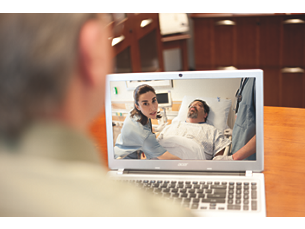- Interoperability
-
Interoperability
Starting with an existing hospital EMR, through an HL-7 interface, eCareManager accesses patient data and provides essential information for the Telehealth Center care team. - Population management
-
Population management
Patient information is presented in a dashboard-style user interface for fast clinical analysis of active conditions and a quick review of assigned tasks. Bi-directional audiovisual controls, as well as clinical data are integrated into a single patient census display to provide the remote clinical team the necessary patient data to provide proactive support to bedside clinicians across patient populations. - Resource management
-
Resource management
Enables a single intensivist and two or three critical care nurses to supplement care for up to 150 beds simultaneously¹, regardless of patient location; helping to optimize existing care-provider staff and leverage every resource in the most efficient way. - Advanced visualization
-
Advanced visualization
Incorporates single-point visualization of data otherwise fragmented across many units and hospitals, and illustrates key physiologic indicators for overall patient health/progression. - Clinical decision support
-
Clinical decision support
eCareManager leverages Smart Alerts® technology to help clinicians systematically assess, analyze and incorporate clinical data into their interventions and care plans. Powered by the Smart Alerts engine, the technology analyzes a patient-specific baseline and underlying conditions; and continuously samples data from patient vital signs, medications, lab results and flowsheets. When a change that meets criteria defined by clinical evidence is detected, Smart Alerts sends a prompt to the care team, enabling them to act quickly.
Interoperability
Interoperability
Population management
Population management
Resource management
Resource management
Advanced visualization
Advanced visualization
Clinical decision support
Clinical decision support
- Interoperability
- Population management
- Resource management
- Advanced visualization
- Interoperability
-
Interoperability
Starting with an existing hospital EMR, through an HL-7 interface, eCareManager accesses patient data and provides essential information for the Telehealth Center care team. - Population management
-
Population management
Patient information is presented in a dashboard-style user interface for fast clinical analysis of active conditions and a quick review of assigned tasks. Bi-directional audiovisual controls, as well as clinical data are integrated into a single patient census display to provide the remote clinical team the necessary patient data to provide proactive support to bedside clinicians across patient populations. - Resource management
-
Resource management
Enables a single intensivist and two or three critical care nurses to supplement care for up to 150 beds simultaneously¹, regardless of patient location; helping to optimize existing care-provider staff and leverage every resource in the most efficient way. - Advanced visualization
-
Advanced visualization
Incorporates single-point visualization of data otherwise fragmented across many units and hospitals, and illustrates key physiologic indicators for overall patient health/progression. - Clinical decision support
-
Clinical decision support
eCareManager leverages Smart Alerts® technology to help clinicians systematically assess, analyze and incorporate clinical data into their interventions and care plans. Powered by the Smart Alerts engine, the technology analyzes a patient-specific baseline and underlying conditions; and continuously samples data from patient vital signs, medications, lab results and flowsheets. When a change that meets criteria defined by clinical evidence is detected, Smart Alerts sends a prompt to the care team, enabling them to act quickly.
Interoperability
Interoperability
Population management
Population management
Resource management
Resource management
Advanced visualization
Advanced visualization
Clinical decision support
Clinical decision support
Documentation
-
Whitepaper (1)
-
Whitepaper
-
Brochure (1)
-
Brochure
- Hospital Virtual Care brochure (1009.7 kB)
-
Whitepaper (1)
-
Whitepaper
-
Brochure (1)
-
Brochure
- Hospital Virtual Care brochure (1009.7 kB)
-
Whitepaper (1)
-
Whitepaper
-
Brochure (1)
-
Brochure
- Hospital Virtual Care brochure (1009.7 kB)
Related products
Alternative products
-
eAcute program
- Clinical decision support that makes a difference
- Program features and services
- Essential, real-time physician support
- Data-driven alert system
View product
-
eICU program
- Clinical transformation in the ICU: Saving lives and reducing costs¹,²
- Program features and services
- Clinical program management
- Experience and workflow design
- Peer benchmarking
View product
-
eAcute program
Stay vigilant and responsive in med/surg and stepdown settings with Philips eAcute. Utilize predictive algorithms, personalized consultations, and remote care to support your bedside teams while delivering the highest quality patient care.
View product
-
eICU program
Predictive, proactive, and patient-centered. Philips eICU leverages critical care specific data, analytics, and decision support to help support your efforts to improve patient outcomes.
View product
- 1. Goran SF and Mullen-Fortino M. Partnership for a Healthy Work Environment: Tele-ICU/ICU Collaborative. AACN Advanced Critical Care. 2012, 23(3): 289-301.


